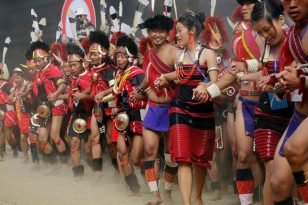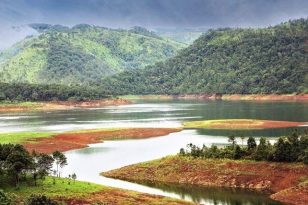Meghalaya is undoubtedly the most beautiful state of all in the North-east. Literally translating to ‘Abode of Clouds’, Meghalaya has picturesque locations that seem to be right out of a painter’s canvas. Geographically, the state comprises of 70% forest area of sub- tropical forests and considered to be the richest botanical habitat in Asia. Pockets of ancient forests are preserved and protected by the communities for hundreds of years due to religious and cultural beliefs, these are known as the sacred groves found in the Mawphlang area. Meghalaya has an estimated 500 limestone and sandstone caves, trained and experienced cavers take caving enthusiastic to some of these exotic caves in Jaintia Hills area. The major tribes of Meghalaya are the Khasis, Jaintias and Garos, who follow a unique matrilineal society, where the lineage and inheritance is traced through women and the youngest daughter inherits all wealth.
Shillong
Shillong, the capital city of Meghalaya is surrounded by rolling green hills, pine trees and majestic waterfalls on the four sides and has been voted as the India’s most favorite hill station. During colonial times, Shillong was the capital of composite Assam and was aptly named by the British as the ‘Scotland of the East’. Although it is a modern city today, certain pockets of Shillong still have the colonial era charm. The three hour drive from Guwahati to Shillong through winding roads opens up spectacular landscapes. Shillong is relatively small with numerous tourist attractions scattered in close distance to each other. Shillong Peak, one of the major attractions is the highest point in the state and offers a panoramic view of the entire city. Other places of interest include Elephant Falls, Wards Lake, Shillong Golf Course, Lady Hydari Park and the State Museum.
Cherrapunjee
Just two hours away from Shillong in the East Khasi Hills district of Meghalaya is the town of Cherrapunjee, which for a long time has been a favorite destination for tourists. Officially rechristened as Sohra, but still globally popular as Cherrapunjee, the town rests on a plateau overlooking the plains of Bangladesh. It was previously known as the wettest place on earth. However, the title is currently held by Mawsynram, a village around 50 kms from Cherrapunji.
The plains in Cherrapunjee closely resemble the grasslands of Europe. Abundant with plant species of various kinds, orange being the most popular, Cherrapunjee brings many trekking options for adventure seekers. Of all the places of interest in and around Cherrapunjee, Nohkalikai Falls certainly takes top honors. Declared the tallest plunge waterfall in India, Nohkalikai Falls falls from alofty height of 1100 ft. and gives out a roar that’s as fascinating as the changing color with each passing hour. Literally meaning ‘jump of Ka Likai,’ the waterfall is attached to an old legend about a woman who jumped off the cliff out of sheer tragic madness at the loss of her daughter. Krem Mawsmai or cave Mawsmai, a 820 feet long limestone cave is another major attraction. Mawsmai cave is well lit up and pretty easy to explore.
But there are many caves full of stalactites and stalagmites, including Krem Mawmluh and Krem Umshyrpi that are challenging enough to excite adventure sports fanatics with activities like spelunking and unmapped caving. The double-decker living root bridge in Nongriat village is another popular attraction of Cherrapunjee.
Mawlynnong
The Cleanest villages in Asia: The picturesque village of Mawlynnong is located in the East Khasi Hills along the India-Bangladesh border, in a distance of about 90 km from Shillong. It has been declared as the cleanest village in Asia by Discover India Magazine in 2003. Tourists have named the village as ‘God’s own garden’ as well. The secret behind the inspiring cleanliness of the village is the collection of waste in conical bamboo bins, which are placed decoratively outside every house. The waste collected is later assembled collectively to be used as manure. With only around 82 houses recorded in 2011, the village of Mawlynnong is a hugely popular eco-tourism destination bundled with wonders of the nature. Streams flowing down from waterfalls, unusual flora like black orchid adds to the beauty of the village. Attached to Mawlynnong is the little village of Riwai, which offers a trek to the living root bridge of Jingkieng Jri, hanging over a small stream. An interesting sight here is the Balancing Rock- which is a humongous rock, balancing naturally on another rock! The ‘Sky Watch’ is an 85 feet high bamboo watchtower that opens up stellar views of the plains of Bangladesh and is quite a popular activity for visitors.
Living Root Bridges
These are architectural marvels of the most unique kind, because even though they are bridges, they were never really constructed, rather grown and groomed over decades and the technique of building passed down through generations. These are bridges built from the roots of the rubber tree across streams by a root guidance system and takes about 15-20 years to complete and survive for hundreds of years. These bridges are a unique way of crossing the streams that swell up during the monsoons. The most famous of these bridges is the double decker decker living root bridges in the village of Nongriat, which involves a trek of around 10 km.
Tours

Eagle’s Nest – Birdwatching Tour
This is an amazing 15-day tour that will take you to Eagle’s Nest along the Indo – Bhutan border, considered to be one of the top birding destinations in the world.
Price: £ 1950

Hornbill Festival Tour
In this trip, visit India’s North East during the Hornbill Festival, where each of the 16 Naga tribes (belonging to the state of Nagaland) showcases its colourful costumes with beads, jewellery, ivory armlets, headgears (made of bamboo, orchids and decorated with boar’s teeth and hornbill’s feathers) and weapons (spears and daos).

Sekrenyi Festival Tour of Nagaland
The tour takes you to the state of Nagaland during the Sekrenyi festival of the Angami tribe and further into remote Nagaland to meet the last of the headhunting Konyak Nagas.

Tawang and its Monasteries
In this trip, you will start your journey in Guwahati, the gateway to North East India, from where you will meander your way through picturesque mountains, Passes, villages teeming with simple faces, and reach Tawang nestled at an altitude of 10,000 feet.
Price: £ 1600

15 days North East India tour: Living Root bridges, Rhinos, Tea & Tribes
In this tour you will visit the North East Indian states of Assam. Meghalaya and Nagaland. The tour begins in Guwahati, the gateway to North East India and also the most important commercial centre of the region.
Price: £ 2450
